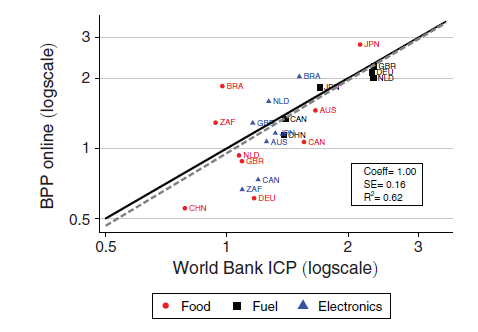Why economists need to use online shopping data
| Date: | 12 November 2018 |
| Author: | Robert Inklaar and Marcel Timmer |

How to compare people’s incomes internationally? How do economists assess which citizens are wealthiest, and which poorest, when costs differ all over the world?
The traditional way is to examine the World Bank’s International Comparison Program (ICP), which collects prices from thousands of comparable goods and services all over the world to calculate Purchasing Power Parities (PPPs). However this relies on traditional data collection by National Statistical Offices. The result? Low frequency of data collection and long delays in publication, as well as issues affecting the comparability of products and methods across countries and time, or the lack of transparency regarding their data and methods.
We set out to show that online prices can be used to construct quarterly purchasing power parities (PPPs), which are published in real-time with a closely-matched basket of goods and identical methodologies in a variety of developed and developing economies.
To achieve our goal, we had to construct our price comparisons across countries. For this, we used micro data available at the Billion Prices Project (BPP) at MIT. Then, we confronted the challenge of matching products. This was a very complex process, because the individual selection of goods that cannot be easily performed owed to the lack of standardisation in product identification numbers and descriptions. Finally, we compared our Price Level Indices (PLIs) results with those of ICP (International Comparison Program) for 2011, the most recent global price comparison.

Despite the differences that we expected due to methods of data collection and frequency, we were able to align well our data with those calculated from ICP data, differing by 15 percent in absolute value across the 11 countries that we select.
Despite the limitations of the online data, such as the lack of representativeness and limited coverage of product categories and countries, we have shown that online prices can be used to enhance ICP data. This dramatically improves the frequency and transparency of purchasing power parities (PPPs) compared with traditional methods. In practical terms, this means that rather than waiting three or more years before new data is available on comparative consumption levels, these online price data can provide new results almost immediately. This improvement in timeliness and frequency would make the resulting data much more useful.
Further reading:
- Cavallo, A., Diewert, W. E., Feenstra, R. C., Inklaar, R., & Timmer, M. (2018). Using Online Prices for Measuring Real Consumption across Countries. AEA Papers and Proceedings, 108, 483-487. DOI:10.1257/pandp.20181037

